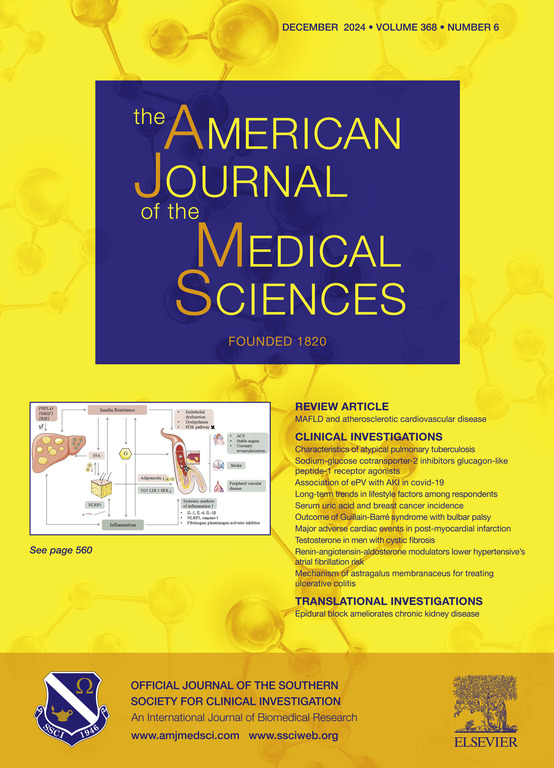Value of the conicity index as an indicator of abdominal obesity in predicting cardiovascular disease and all-cause mortality risk in patients with diabetes based on NHANES data from 1999-2018
IF 2.3
4区 医学
Q2 MEDICINE, GENERAL & INTERNAL
引用次数: 0
Abstract
Objective
The mortality risk among patients with diabetes is increasingly severe, yet the relationship between obesity and mortality risk in these patients remains controversial. This study evaluated the Conicity index (C-index), an indicator of abdominal obesity, to determine its value in predicting cardiovascular disease (CVD) and all-cause mortality in patients with diabetes.
Methods
This cross-sectional study utilized NHANES 1999–2018 data. Patients were grouped into quartiles based on the C-index. The relationship between the C-index and mortality risk was assessed using Cox proportional hazards regression models and restricted cubic spline (RCS) analysis.
Results
A total of 7694 patients with diabetes were included in the study. The obesity rate was 55.7 %, with an average follow-up duration of 88 months. During this period, 588 CVD deaths and 2094 all-cause deaths occurred. Higher C-index quartiles were associated with increased mortality risks, with hazard ratios for all-cause mortality ranging from 1.00 to 2.29 and for CVD mortality from 1.00 to 2.23. Unadjusted RCS analysis showed a linear positive correlation between the C-index and mortality risks. After adjusting for confounding factors, a non-linear positive correlation was observed between the C-index and all-cause mortality risk, particularly when the C-index exceeded 1.40. Subgroup analysis revealed that the relationship between the C-index and all-cause mortality was more significant in men and nonobese patients.
Conclusions
The C-index is a valuable predictor of mortality in patients with diabetes. A C-index above 1.40, being male, and being nonobese are associated with a more significant risk of all-cause mortality.
基于1999-2018年NHANES数据的锥形指数作为腹部肥胖指标在预测糖尿病患者心血管疾病和全因死亡风险中的价值
目的:糖尿病患者的死亡风险日益严重,但肥胖与糖尿病患者死亡风险的关系仍存在争议。本研究评估了腹型肥胖指标锥度指数(C-index),以确定其在预测糖尿病患者心血管疾病(CVD)和全因死亡率方面的价值。方法:本横断面研究使用NHANES 1999-2018年的数据。根据c指数将患者分为四分位数。采用Cox比例风险回归模型和限制性三次样条(RCS)分析评估c指数与死亡风险之间的关系。结果:共有7694例糖尿病患者纳入研究。肥胖率为55.7%,平均随访88个月。在此期间,发生了588例心血管疾病死亡和2094例全因死亡。较高的c指数四分位数与死亡风险增加相关,全因死亡率的风险比在1.00至2.29之间,心血管疾病死亡率的风险比在1.00至2.23之间。未经调整的RCS分析显示c指数与死亡风险呈线性正相关。在校正混杂因素后,c指数与全因死亡风险呈非线性正相关,特别是当c指数超过1.40时。亚组分析显示,c指数与全因死亡率之间的关系在男性和非肥胖患者中更为显著。结论:c指数是糖尿病患者死亡率的一个有价值的预测指标。c指数高于1.40、男性和非肥胖人群的全因死亡率更高。
本文章由计算机程序翻译,如有差异,请以英文原文为准。
求助全文
约1分钟内获得全文
求助全文
来源期刊
CiteScore
4.40
自引率
0.00%
发文量
303
审稿时长
1.5 months
期刊介绍:
The American Journal of The Medical Sciences (AJMS), founded in 1820, is the 2nd oldest medical journal in the United States. The AJMS is the official journal of the Southern Society for Clinical Investigation (SSCI). The SSCI is dedicated to the advancement of medical research and the exchange of knowledge, information and ideas. Its members are committed to mentoring future generations of medical investigators and promoting careers in academic medicine. The AJMS publishes, on a monthly basis, peer-reviewed articles in the field of internal medicine and its subspecialties, which include:
Original clinical and basic science investigations
Review articles
Online Images in the Medical Sciences
Special Features Include:
Patient-Centered Focused Reviews
History of Medicine
The Science of Medical Education.

 求助内容:
求助内容: 应助结果提醒方式:
应助结果提醒方式:


